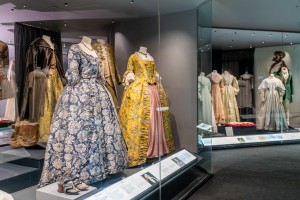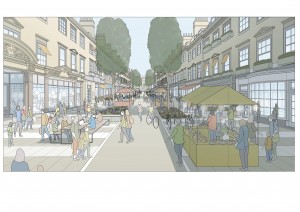Bath’s world-leading Fashion Museum is set to relocate to a major building in the city centre in a move that will also kick-start the transformation of the surrounding area into a new creative quarter.
Bath & North East Somerset Council (B&NES) is poised to buy the 22,000 sq ft building in what will be branded as the Milsom Quarter to rehouse the museum, which has to move out of the Assembly Rooms after almost 60 years.

A report to the West of England Combined Authority (WECA), which will fund the building’s acquisition, described the museum as internationally significant and key for the recovery of Bath’s pandemic-hit tourism sector.
The relocated museum would also act as a catalyst for the transformation of the area into a new fashion quarter, attracting high-end retailers and workspaces for creative businesses.
Last week Bath Business News revealed how the Milsom Quarter masterplan – described by the council as a vision for the next 20 years, pictured below – could also include 180 new homes in the area, which stretches from George Street in the north to Upper Borough Walls in the south, and west from Queen Square to the Cattlemarket car park.
The WECA report says it is imperative to buy the large building, which has not been identified but is currently used for retail and residential accommodation, now to ensure the site does not stay empty indefinitely, which it claimed would “drag down the quarter and undermining the wider masterplan”.

The report continues: “With an over-supply of retail units in the vicinity, it is unlikely that the private sector will be interested in the opportunity to obtain the site for this use.
“Conversion costs to residential and/or hotel would be expensive and risky, and it would be questionable whether they would deliver the same placemaking, economic and community benefits of a world-class modern museum.
“This new institution will be an anchor tenant in Milsom Quarter, vital to the overall success of the masterplan through its ability to attract additional footfall, drive higher spend, increase dwell time, improve the desirability of the area to commercial and private tenants and underpin an authentic and unique sense of place in what has long been the city’s fashion retail hub.”
WECA’s recently launched cultural strategy concluded that the region’s visitor economy had been decimated by the pandemic, particularly in Bath.
“The future success and vitality of Bath is explicitly linked to a strong, innovative and vibrant attraction sector which in-turn helps power the economy of the city and the wider region,” the WECA report adds. “It is in this context that a major new, internationally significant museum project, justifies regional investment.
“Securing a location for the museum will bring strong momentum to the design development and case for support for the new project – allowing B&NES to access further funding.”
A second report by B&NES says a purchase price and heads of terms have already been agreed in principle on the building, the freehold of which is already owned by the council.
“The property has not been brought to the open market. Discussions have been on-going with the vendor’s agent due to the council being considered to have ‘special’ purchaser interest, as the freeholder,” the report adds.
Originally called the Museum of Costume, the Fashion Museum opened in the Assembly Rooms in 1963 after costume designer, collector, writer and scholar Doris Langley Moore OBE donated her private collection to the city.
It changed its name in 2007. Pre-Covid, it attracted more than 100,000 visitors a year.
Through its extensive work with partners in education, industry and heritage, the museum plays its part in shaping the future of fashion and its role within society.
Designated by government as a collection of national significance under the scheme run by Arts Council England, the collection includes more than 100,000 objects, making it one of the largest museum collections of historic and contemporary fashionable dress in the world.
It includes garments from the 1600s right up to the present day. The collections also include thousands of fashion archive documents, photographs and drawings, including the work of fashion designers, makers and retailers.
The Fashion Museum also has an international reach. In 2021 more than 603,000 people worldwide saw Fashion Museum objects, thanks to its loans programme.
The council had been given notice to vacate the Assembly Rooms by owner the National Trust by next March. This week the council said the museum’s last day of opening will be Sunday 30 October, following which the collection will move to temporary accommodation.
The council said due to the scale of what will be one of the most significant cultural infrastructure projects in the UK, the new Fashion Museum and Collections Study Centre are likely to be completed in the next five to eight years.
The Collections Study Centre is expected to be housed in a purpose-built facility on a council-owned site in Locksbrook, next to a significant new development by Bath Spa University for all its creative courses. The university’s fashion courses rely heavily in the collection.
Bath & North East Somerset Council cabinet member for children and young people, communities and culture, Cllr Dine Romero, said: “This is an exciting new chapter in the Fashion Museum’s long history. Since 1963, it has been connecting people with fashion and it will continue to do so for many years to come.
“Although the museum is leaving its current home, this is an opportunity to look at how it can best serve its audiences. The new Collections Study Centre will be a home for our world-class collection of 100,000-plus objects and will also provide us with a space to offer events and access to the museum collection for anyone who wants to see it.
“The public, industry experts and academics will all be able to visit the Collections Study Centre and take a closer look at the collection, beyond what is on display in the museum.”



















